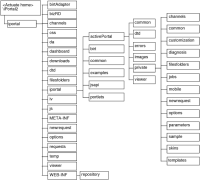

Directory | Contents |
This directory | landing.jsp, the default page for accessing all Information Console functionality. |
birtAdapter | BIRT Viewer integration files. |
bizRD | Pages that support BIRT Studio. |
channels | Pages that support channels. |
css | Actuate Information Console cascading style sheet (.css) files. |
da | BIRT Data Analyzer support files. |
dashboard | Dashboard support files. |
downloads | Downloaded files. |
dtd | Document type definitions. |
filesfolders | Pages that support working with files and folders. |
images | Information Console user interface images and icons. |
iportal | The Information Console application. |
iv | Pages that support Interactive Viewer. |
js | JavaScript files that control specific web page elements such as search, toolbar, and table of contents. |
logs | Administrative and SOAP fault log files. |
META-INF | The Information Console manifest file. iHub embedded InfoConsole directory. |
newrequest | Pages that support new requests, such as parameter processing, scheduling, and job status pages. |
options | Options-specific pages, such as channels, notification, and options update pages. |
requests | Pages in this directory provide backward compatibility for custom web applications referencing these pages by URL. Use the action paths and the private\jobs directory for new customization projects. |
temp | Working directory for transient content. |
viewer | Pages that support report viewing. |
WEB-INF | Files that manage session information such as current user login, roles, and volume. |
Directory | Contents |
activePortal | Pages that support login and authentication and directories for the remaining pages for folder navigation and document usage |
birt | Libraries that support BIRT reports, BIRT Studio, and Interactive Viewer and pages that support BIRT reports |
common | Common elements included in all reporting web pages, such as banner and side menu elements |
jsapi | The Java Report Engine Manager |
Directory | Contents |
This directory | Pages that support login and authentication and directories for the remaining folder and document pages for the Information Console application. |
common | Common elements included in all reporting web pages, such as banner and side menu elements. |
dtd | Document type definitions. |
errors | Error pages. |
images | Images for reporting web pages, such as buttons, icons, lines, and arrows. |
private | Most Information Console folders and documents web pages. Users cannot directly access pages in this directory using URLs. These pages are customizable. |
private\channels | Pages that support channels. |
private\common | Common elements included in all reporting web pages, such as banner and side menu elements. |
private\customization | Pages that support customization of skins. |
private\diagnosis | Self-diagnostic utility page. |
private\filesfolders | Pages that support working with files and folders. |
private\jobs | Pages that support requests such as completed requests, successful submission, and details pages by redirecting. |
private\mobile | Pages that support BIRT Mobile subscriptions. |
private\newrequest | Pages that support new requests, such as parameter processing, scheduling, and job status pages. |
private\options | Options-specific pages, such as channels, notification, and options update pages. |
private\parameters | Pages that support table parameters. |
private\sample | Example custom requester page. |
private\skins | Skins definitions. |
private\templates | Jakarta Struts template pages that simplify customization by handling common web page structure and functionality for many pages. |
viewer | Pages that support report viewing. |